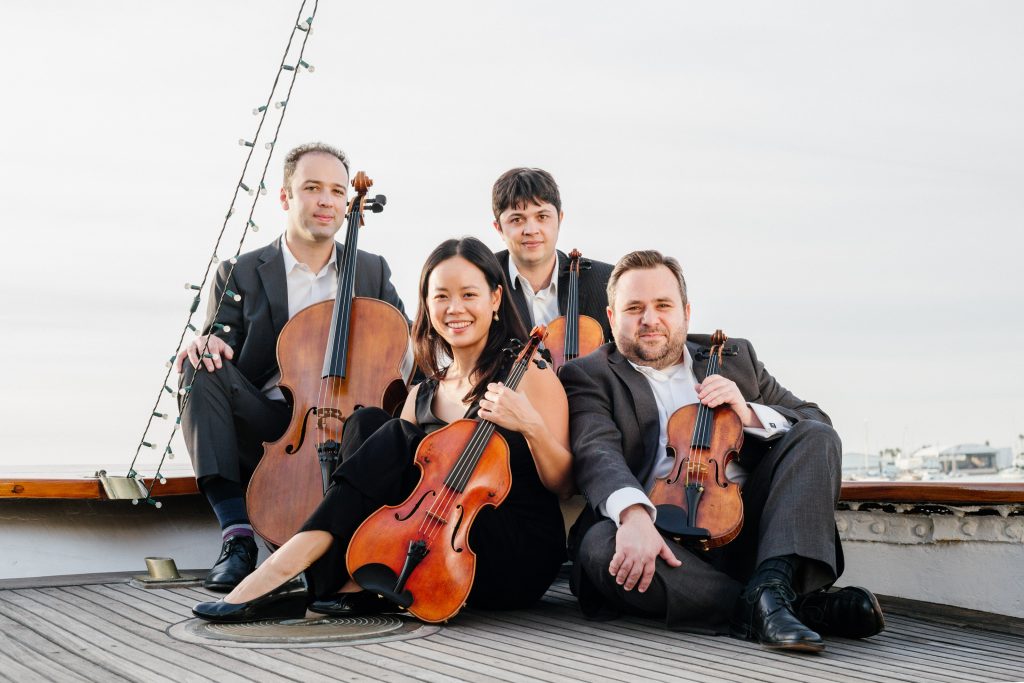Hausmann Quartet Spans the Centuries Gracefully at the Maritime Museum of San Diego
Although the ferryboat Berkeley remained securely docked at the edge of San Diego Bay, on Sunday (February 25), the Hausmann Quartet embarked on another year of its Haydn Voyages: Music at the Maritime. These intrepid four string players are sauntering their way through the entire Haydn string quartet canon in a multiyear project, wisely including contrasting selections from other composers along the way.

Hausmann Quartet: (from left) Alex Greenbaum, Angela Choong, Isaac Allen, Bram Goldstein [photo (c) Samantha Zauscher]
Seeger’s flinty, modernist Quartet from 1931 proved a perfect foil for Haydn’s robust, probing String Quartet in D Minor, Op. 9, No. 4 from 1769. In 1930 Crawford Seeger became the first woman to receive the prestigious Guggenheim Fellowship, allowing her a year of European study, although she had already developed her own compositional style, which she called dissonant counterpoint.
The more active sections of her String Quartet, notably the Allegro Possible movement, displayed her spikey counterpoint, reminding me of that edgy neoclassical idiom propounded by Paul Hindemith in the years after World War I. But her slowly changing, tightly layered conflicting lines of the Andante looked forward in an uncanny way to the texture and emotional edge of Tina Tallon’s first movement of “Selective Defrosting,” which Hausmann had played on their program’s first half.
What linked Crawford Seeger to the Haydn D Minor Quartet was her fascination with architecture, building elegant structures clad in the glow of warm string sonorities. Haydn, of course, had a penchant for spinning out winsome themes, but by the 1930s, progressive composers such as Crawford Seeger frowned on pretty tunes as pandering.
Hausmann gave us their best playing in the Haydn D Minor String Quartet: vigorous in spirit, but refined in execution. Angela Choong’s opulent viola and Alex Greenbaum’s suave prowess on cello complemented the assured, well-matched violinists Issac Allen and Bram Goldstein, and Allen offered a sleek, heartfelt cantabile solo in the lovely Adagio movement. Their opening Haydn String Quartet in D Major, Op. 1, No. 3, proved a pleasant appetizer, but left a modest impression at best. As Hausmann’s resident musicologist Derek Katz explained in his thoughtful introduction, this early Haydn quartet was only intended for the pleasure of the musicians playing together. Only as the string quartet matured as a medium did it attract avid listeners.
Tina Tallon’s 2012 “Selective Defrosting” began slowly and mysteriously, but soon opened up with explosive extended techniques. The engaging, agitated middle movement sported raucous pizzicatos, pulsing tremolandos, and uses of the bow on the strings I’m certain teachers warn young students never to do, and the final movement returned to the quiet ethos in which the piece began.
The Hausmann Quartet presented this concert on Sunday, February 25, 2018, at the Maritime Museum of San Diego’s Berkeley ferryboat. The next program in this Haydn Voyages series is slated for May 6, 2018.

Ken Herman, a classically trained pianist and organist, has covered music for the San Diego Union, the Los Angeles Times’ San Diego Edition, and for sandiego.com. He has won numerous awards, including first place for Live Performance and Opera Reviews in the 2017, the 2018, and the 2019 Excellence in Journalism Awards competition held by the San Diego Press Club. A Chicago native, he came to San Diego to pursue a graduate degree and stayed.Read more…
